You’ll find Williams makes a perfect base for Grand Canyon adventures and classic Route 66 nostalgia, with a restored 1908 depot, vintage motels, neon signs, and outdoor options from Bearizona wildlife drives to Kaibab National Forest hikes. Whether you’re after scenic train rides, family-friendly attractions, or quiet mornings at a cozy B&B, there’s plenty to plan—so let’s walk through the 25 best things to do and pick what fits your trip.
Explore the Grand Canyon Railway and Depot
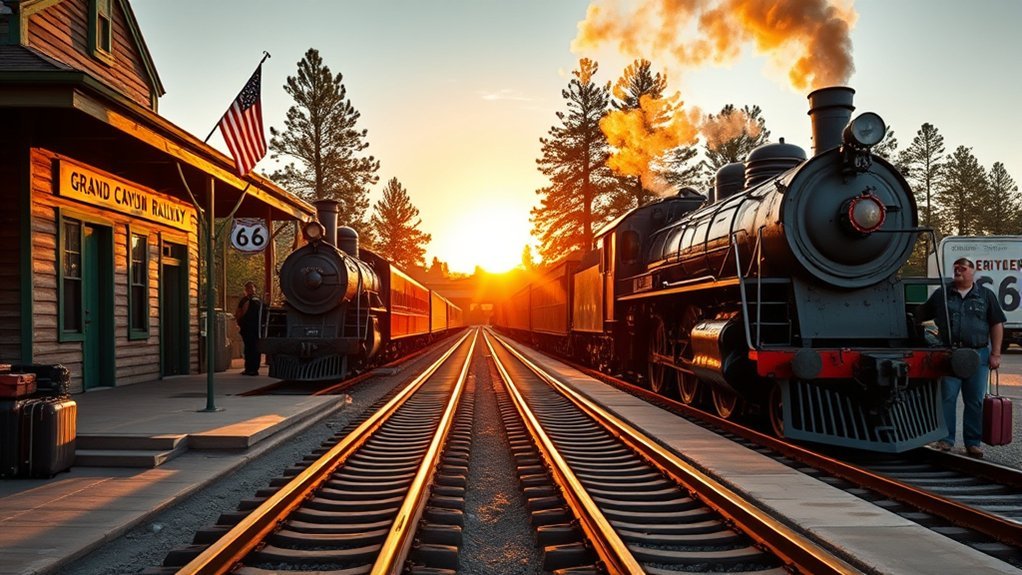
Step back aboard a living piece of the Old West as you ride the Grand Canyon Railway from Williams to the South Rim. You’ll climb into vintage coaches where polished wood, brass fixtures, and period details set the scene for a scenic, comfortable journey. Engineers and conductors in traditional attire narrate history and point out landmarks, so you won’t miss geological highlights or local lore. Expect photo-worthy views as the train winds through ponderosa forests, high desert, and meadows, with occasional wildlife glimpses. At the restored 1908 depot, you can explore exhibits on railroad history, view artifacts, and shop for themed keepsakes that reflect the line’s century-old significance. Seasonal specials—dinner trains, holiday rides, and staged entertainment—add variety, so check schedules before you go. You’ll disembark refreshed and informed, ready to continue your Grand Canyon adventure with a richer sense of place and the region’s railroad heritage.
Stroll Historic Route 66 and Neon Signs
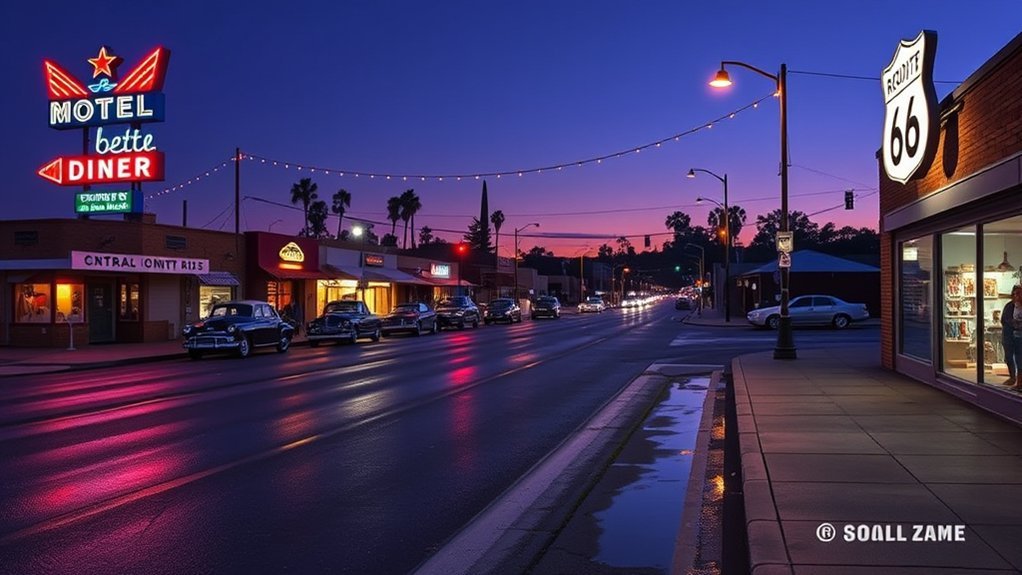
Walk down Historic Route 66 in Williams and you’ll find a brightly preserved slice of Americana where vintage neon signs, classic motels, and roadside diners light up a nostalgic streetscape. You’ll wander past glowing marquees and chrome-trimmed façades, imagining roadtrips from a bygone era. Stop to photograph the iconic neon — its warm reds and blues pop at dusk — and peek into diners for pie and coffee that feel timeless. Local shopkeepers’ll share stories about sign restorations and the town’s Route 66 revival. Use the table below to spot must-see signs and photo tips as you stroll.
| Sign/Spot | Best Time | Photo Tip |
|---|---|---|
| Little Daisy Motel | Evening | Frame with sunset sky |
| Cruiser’s Diner | Morning | Capture neon reflections |
| Route 66 Gateway | Golden hour | Wide-angle from center |
Take your time, follow the glow, and let those neon lights guide a charming, easygoing exploration of Williams’s Route 66 heritage.
Hike in Kaibab National Forest
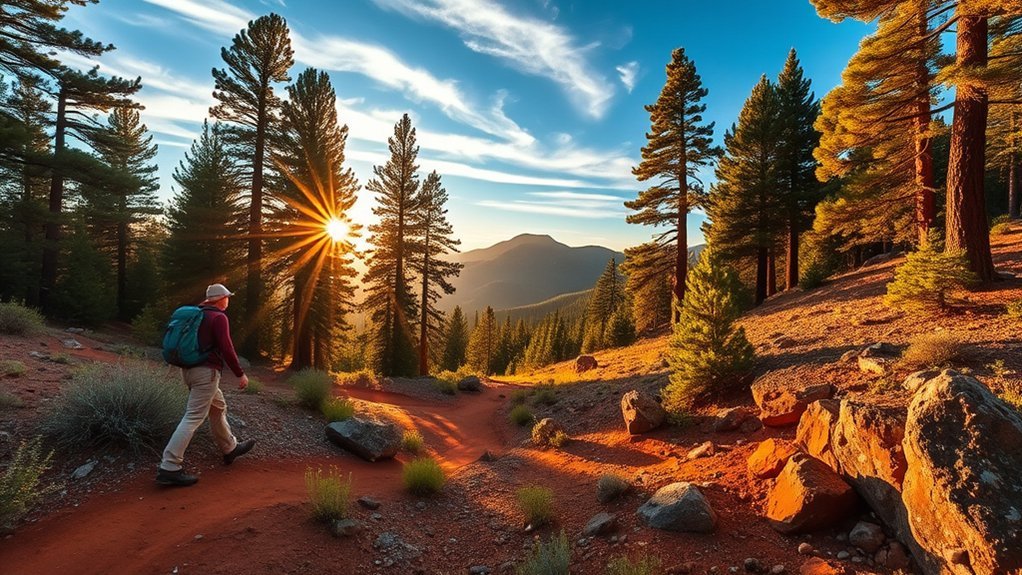
After you’ve soaked up neon and diner lore on Route 66, head into the cool pines of Kaibab National Forest where the landscape changes from vintage roadside charm to sweeping wilderness. You’ll find trails for every appetite: short loops that skirt aspen groves and longer routes that drop into canyons or climb ridgelines with Grand Canyon vistas. Pay attention to elevation — mornings are crisp and afternoons warm, so layer up and carry water; altitude can sneak up on you. Watch for mule deer, songbirds, and the occasional elk track, and respect wildlife by observing from a distance. Trailheads near Williams, like Bill Williams Mountain and Kaibab Lake, are well marked and offer maps and parking. Pack sunscreen, a first-aid kit, and a charged phone with offline maps. Leave no trace: pack out trash, stay on marked paths, and avoid cutting switchbacks. Hiking here rewards you with quiet forests, panoramic views, and a real sense of solitude.
Visit Bearizona Wildlife Park
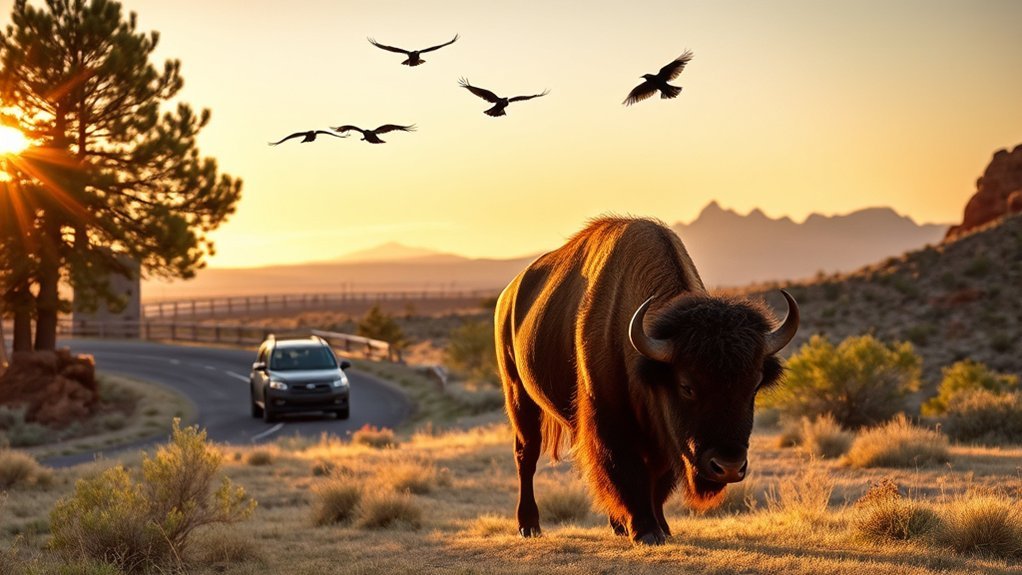
Drive into Bearizona Wildlife Park to meet North American wildlife roaming in spacious, natural-looking enclosures you can view from the safety of your car or on foot in the walk-through area. You’ll cruise past bison, elk, and bears, camera ready as animals move at their own pace. The walk-through offers up-close views of smaller predators and birds; interpretive signs explain behavior and conservation. Keep windows partially up near large mammals and follow staff guidance for safety. Timing matters—cool mornings or late afternoons mean more activity. Plan for a picnic at scenic spots and stop by the gift shop for local-made souvenirs. You’ll leave with a clearer sense of regional ecosystems and the park’s rescue-and-rehab mission.
| Feature | Tip |
|---|---|
| Drive-thru route | Bring water, sunshade |
| Walk-through area | Wear sturdy shoes |
| Wildlife viewing | Use binoculars |
| Feeding policy | Don’t feed animals |
| Educational talks | Check schedule before visiting |
Ride the Polar Express (seasonal)
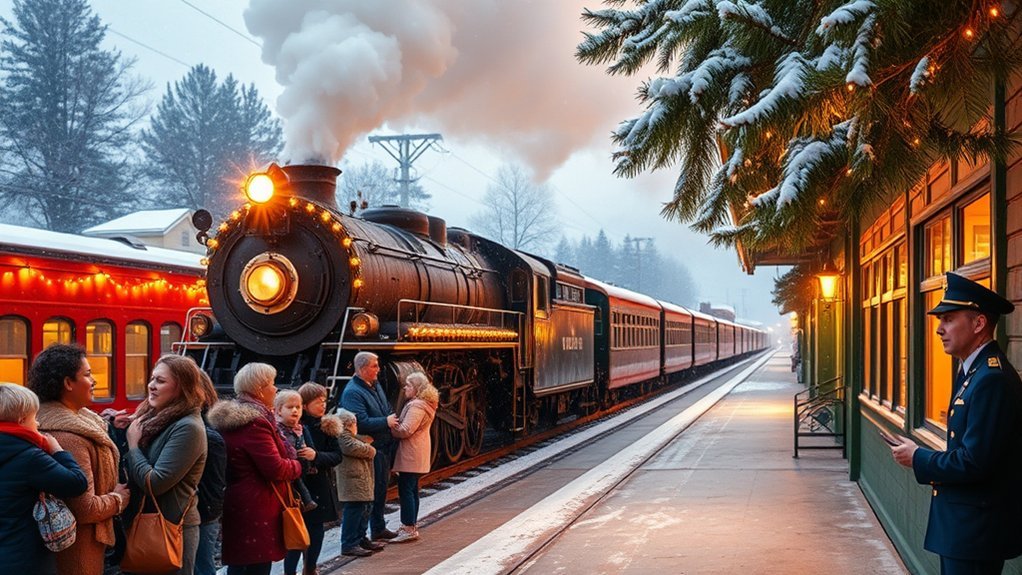
Hop aboard the Polar Express for a festive, theatrical ride through snowy scenery where actors, hot cocoa, and a gift for every child make the journey magical. You’ll want to buy tickets well in advance and arrive early for smooth boarding and best seating. Follow the event’s instructions for parking, baggage, and accessibility so your family can relax and enjoy the experience.
Festive Train Experience
A short, magical ride on the Grand Canyon Railway’s Polar Express will plunge you into a holiday storybook complete with twinkling lights, costumed conductors, and hot chocolate served right at your seat. You’ll board amid carols as actors bring the tale to life, handing out golden tickets and encouraging sing-alongs. The carriage decorations, gentle clack of rails, and scenic desert twilight make the journey feel intimate and cinematic. Kids and adults alike lean in when Santa appears, creating a shared moment you’ll remember.
| Feature | Experience |
|---|---|
| Atmosphere | Festive lights, period decor |
| Entertainment | Live actors, sing-alongs |
| Treats | Hot chocolate, cookies |
| Photo Ops | Santa visit, decorated cars |
Ticketing & Boarding Tips
Before you go, buy tickets early and print or download them to your phone—Polar Express rides sell out fast, especially weekend and evening departures. When you arrive, aim to be at the depot at least 30–45 minutes before departure to grab seating, restroom time, and pre-boarding photos. Staff scan tickets quickly, so have them accessible and fully charged. Dress warmly for outdoor waiting and cooler cars; layers, hats, and gloves make the ride cozier. If you need accessible seating or have a large group, call ahead to reserve specific accommodations. Keep small children’s snacks and motion-sickness remedies handy. Finally, follow boarding zones and crew instructions—they keep departures smooth and make certain everyone enjoys the magical, family-friendly experience.
Tour the Williams Depot Railroad Museum
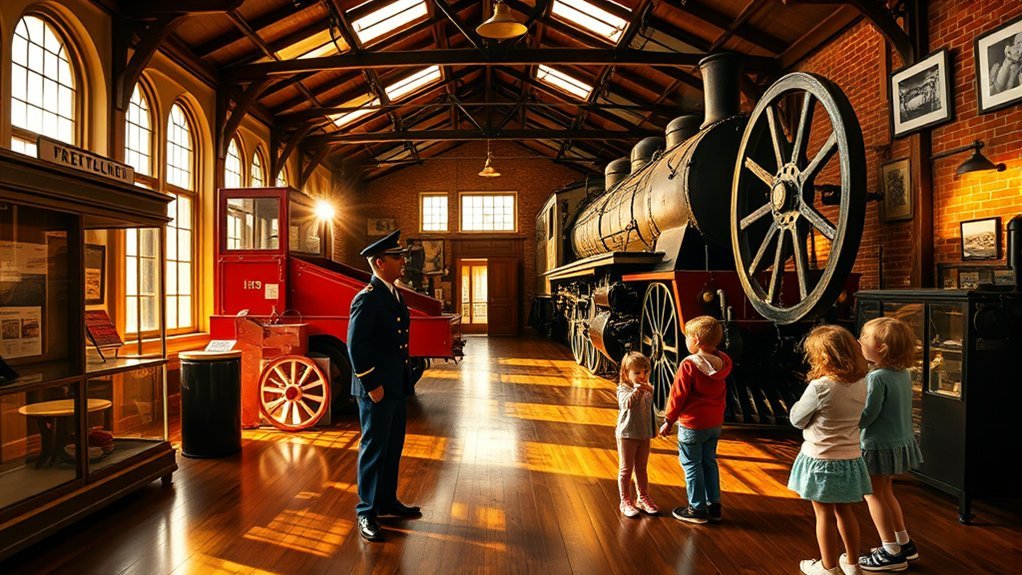
Step into the historic Williams Depot and you’ll feel the town’s railroad past come alive through preserved architecture and interpretive displays. You can learn about the Depot’s role in connecting Williams to the Grand Canyon, then hop on a vintage car for a scenic Grand Canyon Railway ride. Inside the museum, curated exhibits and authentic artifacts—tickets, timetables, and rail equipment—paint a vivid picture of railroading life.
History of the Depot
Wander into the Williams Depot Railroad Museum and you’ll step straight into the town’s railroad heartbeat, where the depot’s 1908 stone-and-wood structure still echoes with the clang of a bygone era. You’ll trace the depot’s rise from frontier water stop to bustling rail hub, see original ticket windows, telegraph gear, and interpretive panels that explain how rail linked Arizona to the rest of the country. Photographs and artifacts show crews, freight, and the town’s growth around the tracks. You’ll learn about preservation efforts that saved the building and how locals kept its stories alive. Below is a quick snapshot to guide your visit:
| Feature | Note |
|---|---|
| Year built | 1908 |
| Materials | Stone & wood |
| Highlights | Ticket window, telegraph |
| Preservation | Restored by community |
Grand Canyon Railway Rides
Climb aboard the Grand Canyon Railway for a ride that turns the Williams Depot into more than a museum stop—it’s your launching point for a living, whistle-blowing journey back in time. You’ll feel the rhythm of rails beneath you as vintage cars glide through Ponderosa pines toward the canyon rim. Staff in period attire narrate stories of frontier travel, helping you imagine early explorers and railroad crews. Snap photos of sweeping landscapes, listen for the steam whistle, and savor the relaxed pace that contrasts with modern travel.
- Take a dome car for panoramic views.
- Opt for a first-class parlor for added comfort.
- Book a themed ride (dinner, murder mystery).
- Arrive early to explore the depot grounds.
Museum Exhibits & Artifacts
While the depot still hums with departing trains, its museum invites you to slow down and explore the artifacts that trace Williams’ railroading past. You’ll wander through restored coaches, station signs, uniforms, and vintage photographs that make history feel immediate. Interactive displays let you touch tools and hear oral histories, and a model layout shows how lines threaded the landscape. Docents share quick stories about steam-era challenges and the town’s role as a gateway to the Grand Canyon. You’ll leave with a clearer sense of how railroads shaped daily life here.
| Artifact | Description |
|---|---|
| Steam locomotive parts | Boiler fittings, gauges |
| Conductor uniform | Original cap and badge |
| Signal lamp | Worked at nearby junctions |
| Photograph archive | Early 1900s images |
| Model layout | Detailed town and track replica |
Drive the Kaibab Plateau Scenic Byway
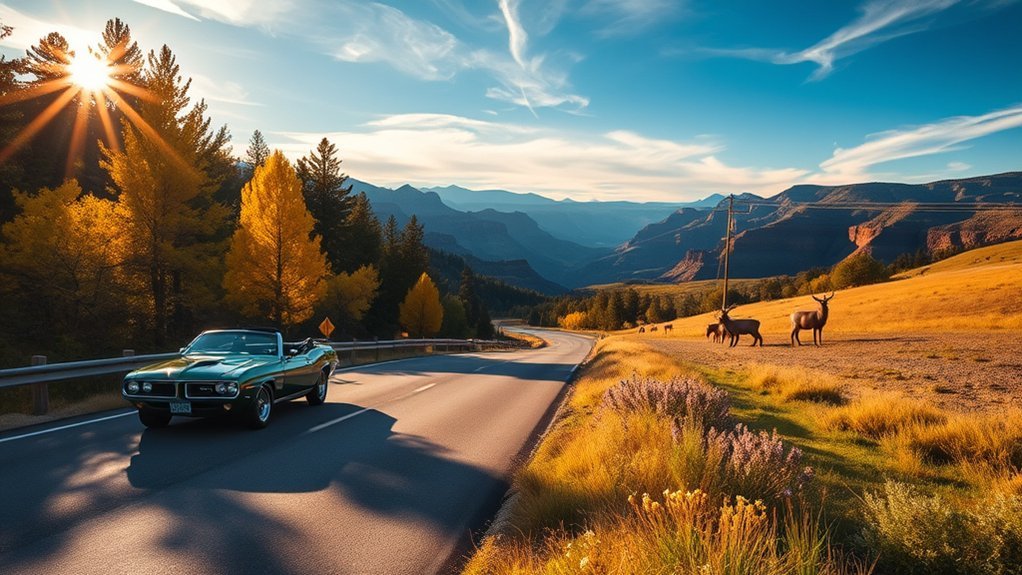
Start your engine and head north—this scenic drive along the Kaibab Plateau Scenic Byway unfurls high-elevation forests, sweeping overlooks, and surprising wildlife just a short distance from Williams. You’ll climb into fragrant ponderosa pines and aspen groves, watching the temperature drop and the horizon broaden. Pull over often; viewpoints reveal layered mesas and distant canyon rims where light sculpts the land.
- Plan short stops at designated pullouts for safe photo ops and quick hikes.
- Bring layered clothing—weather shifts fast at higher elevations.
- Carry water and snacks; services are sparse along the route.
- Respect speed limits and stay on paved areas to protect fragile tundra-like meadows.
The road’s gentle curves make for relaxed driving, and interpretive signs explain geology and ecology. You’ll leave the ordinary behind, trading Route 66 nostalgia for alpine panoramas. Time your trip for clear skies to maximize visibility and the sense of wilderness just beyond Williams.
Spot Elk at Kaibab National Forest Viewing Areas
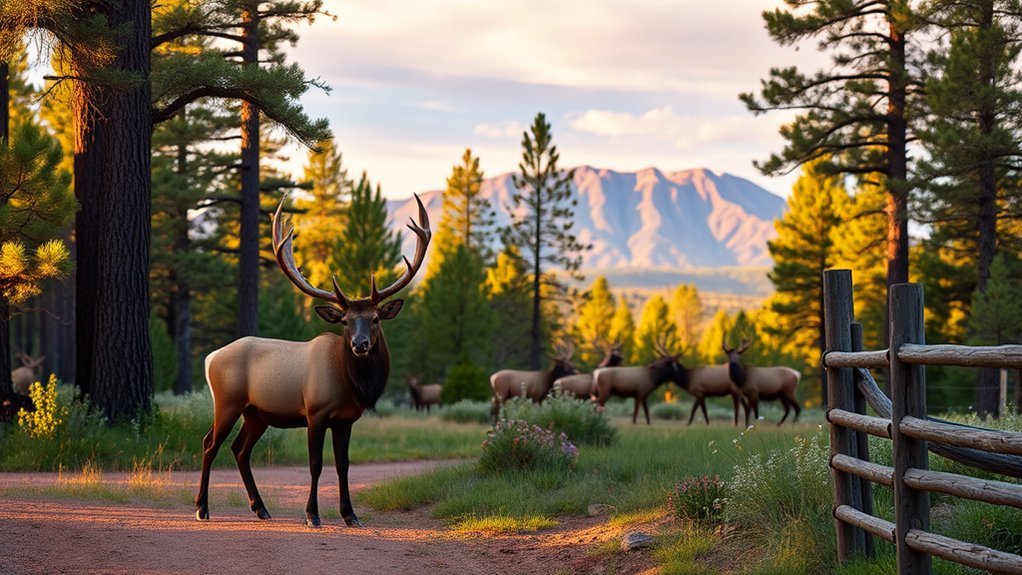
You’ll want to plan your visit around dawn and dusk, when elk are most active and the light is best for spotting them. Head to hotspots like House Rock, North Kaibab near Jacob Lake, and the meadows along Highway 64 for reliable sightings. Bring binoculars, stay quiet, and keep a respectful distance to enjoy the show without disturbing the animals.
Best Viewing Times
Often the best elk viewing happens at dawn and dusk, when animals move from feeding areas into the forest edge and you’re most likely to see bulls and cows grazing or bugling. You’ll want to plan quiet, patient outings during these cooling or warming hours when light paints the meadows and elk are most active. Bring layers, a spotting scope or binoculars, and stay downwind to avoid alerting them. Follow rules, keep distance, and move slowly to preserve the moment.
- Arrive 30–60 minutes before sunrise or stay 30–60 minutes after sunset.
- Visit late spring through early fall for calf and rutting behaviors.
- Choose overcast or calm mornings for easier detection.
- Avoid midday; elk bed in dense cover then.
Top Viewing Spots
Because elk favor the mix of open meadows and dense timber along the Kaibab, you can plan visits around a handful of reliable viewing areas where animals are frequently spotted grazing, bugling, or moving between cover and forage. Drive the Kaibab Plateau Road at dawn or dusk to catch elk in willow flats by roadside pullouts; binoculars and a telephoto lens help you watch without disturbing them. Check the Forest Service’s Doney Park and Bill Williams River trailheads for glimpses near riparian zones. For a quieter experience, hike short trails off Forest Road 22 to hidden clearings where elk stop to feed. Always keep distance, use designated parking, and follow seasonal closures—your respect keeps elk wild and viewing safe.
Browse Shops on Railroad Avenue
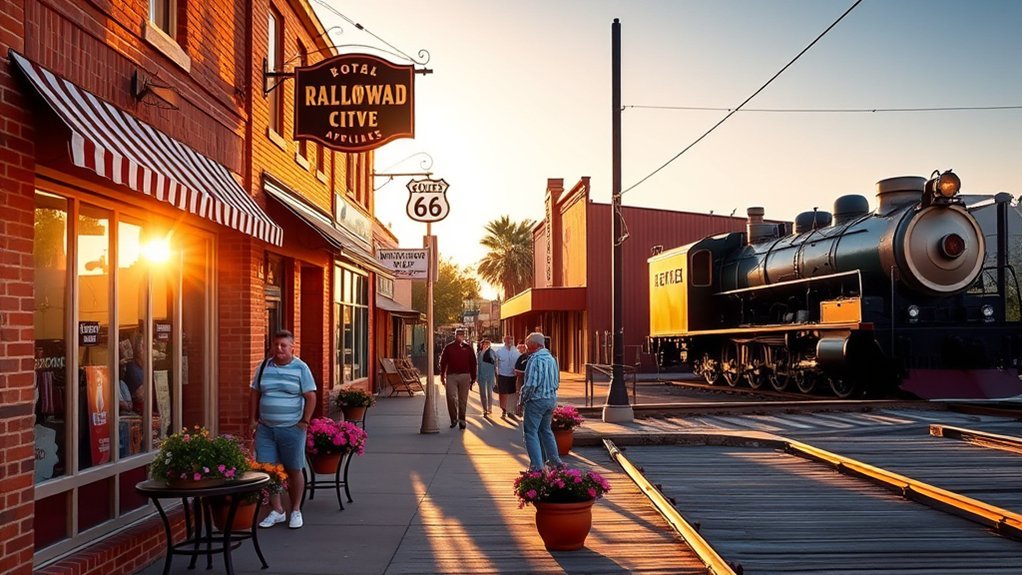
Stroll down Railroad Avenue and you’ll find a compact, colorful strip where Old West charm mixes with modern boutiques and galleries. You’ll want to linger—window displays showcase Native American jewelry, handcrafted leather goods, vintage Route 66 memorabilia, and local art that captures the high-desert light. Shopkeepers are friendly and ready to tell a story about a piece, making each purchase feel personal.
Stroll Railroad Avenue’s colorful strip—Old West charm, friendly shopkeepers, and handcrafted treasures that beg you to linger.
- Visit galleries for paintings and photography inspired by the Grand Canyon and surrounding landscapes.
- Hunt for unique souvenirs: turquoise, silverwork, and hand-tooled belts you won’t find in chain stores.
- Drop into antiques and vintage shops to uncover retro signs, postcards, and collectibles.
- Browse specialty stores for outdoor gear, maps, and locally made snacks before you head back out.
You’ll appreciate the relaxed pace and easy strollability—shops are close together, so you can sample several in a single outing without rushing.
Dine at Classic Route 66 Diners
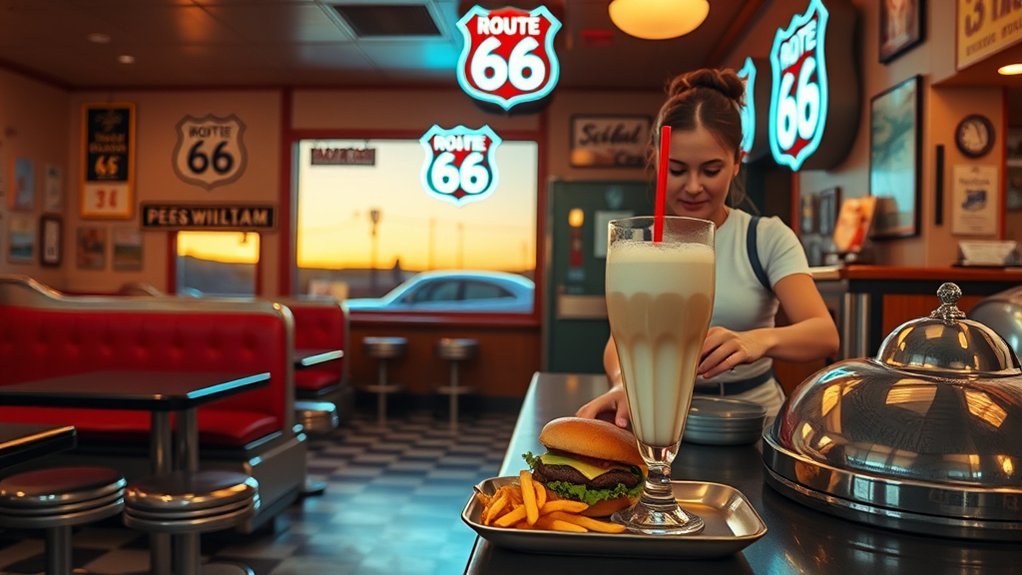
Step into a neon-lit diner on Historic Route 66 and you’ll feel like you’ve time-traveled to a wilder, friendlier era—chrome stools, checkerboard floors, and milkshakes churned to order. You’ll find hearty breakfasts, classic burgers, and pies baked the old-fashioned way, each plate served with a side of local stories. Chat with servers who’ve worked here for years and learn which booths hosted travelers, musicians, or Route 66 lore. Menus emphasize comfort: thick-cut sandwiches, hand-dipped shakes, and coffee that keeps you planning your next stop. Diners are also surprisingly good for people with dietary needs—many offer gluten-free or vegetarian options if you ask. Pay attention to vintage signs, jukeboxes, and memorabilia; they’re part of the meal’s charm. Whether you’re fueling up before a Grand Canyon day trip or lingering after sunset, these eateries deliver a tasty, authentic snapshot of Americana that’s both casual and unforgettable.
Picnic and Birdwatch at Woody Mountain Trailhead
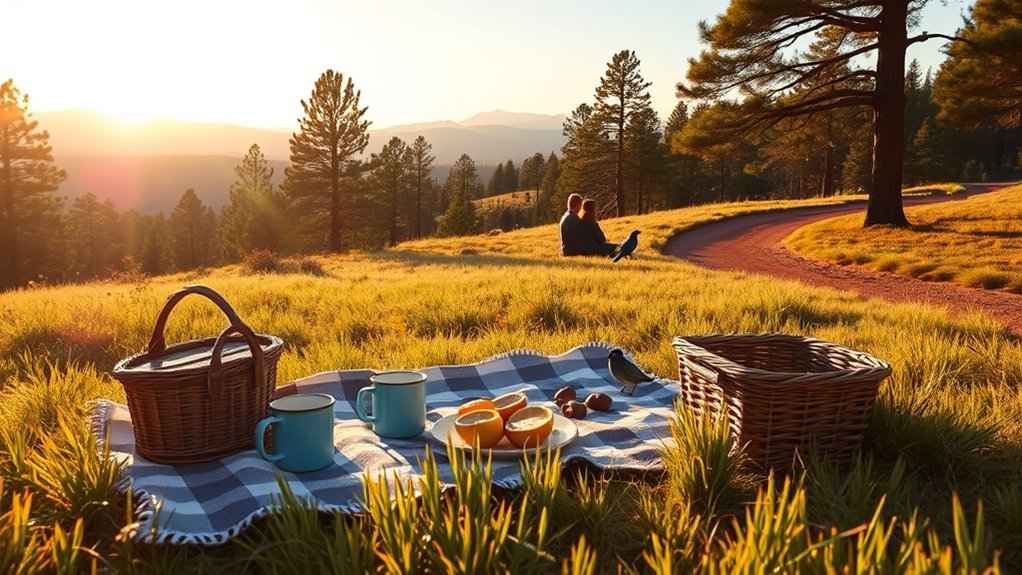
After a satisfying meal on Route 66, head into the pines to unwind at the Woody Mountain Trailhead, where open meadows and shady groves make a perfect spot for a picnic and some birdwatching. You’ll find flat grassy areas ideal for spreading a blanket and trees that shelter you from midday sun. Bring a compact field guide and binoculars; residents include scrub jays, western bluebirds, and woodpeckers that tap in the canopy. Trails radiate from the parking area, so you can alternate lounging with short walks to scout different habitats.
After Route 66, relax at Woody Mountain Trailhead—meadows, shady groves, birdwatching, short loop hikes, and picnic spots.
- Pack light: sandwich, water, sunscreen, and a small trash bag.
- Timing matters: early morning or late afternoon yields the best bird activity.
- Respect wildlife: keep distance and avoid feeding birds.
- Quick hike options: several loop trails under a mile each.
You’ll leave refreshed, with photos and sightings that capture the quiet mountain rhythm.
Take a Guided ATV or Jeep Tour
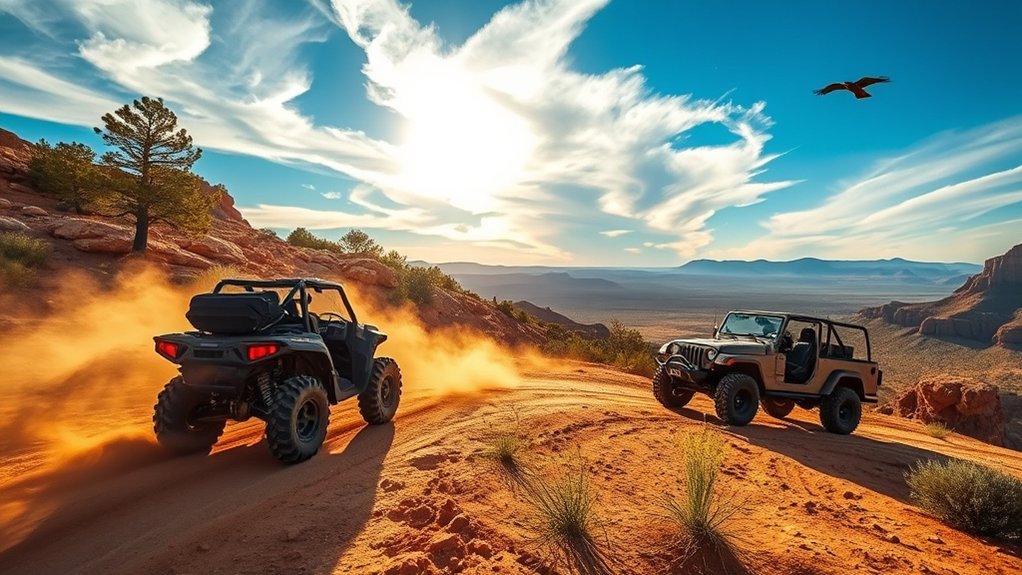
Hop into a guided ATV or Jeep tour to blast off-road into rugged high-country terrain without worrying about navigation or gear — experienced guides handle the route, safety briefings, and local lore so you can focus on the views. You’ll drive through ponderosa pine forests, across red-rock washes, and along ridgelines that reveal sweeping vistas of the Kaibab Plateau. Guides point out geological features, local wildlife tracks, and historical sites you’d likely miss on your own. Tours vary in length and difficulty, from gentle scenic runs suitable for beginners to adrenaline-pumping trails for seasoned riders; operators provide helmets, goggles, and clear instructions. Expect small-group pacing, photo stops at lookout points, and weather-aware planning—spring and fall offer the most comfortable conditions. Bring layered clothing, closed-toe shoes, sunscreen, and a charged phone in a secure case. By the time you return to town, you’ll have a fresh perspective on northern Arizona’s backcountry and a handful of memorable photos.
Attend the Williams Annual Railroad Days Festival
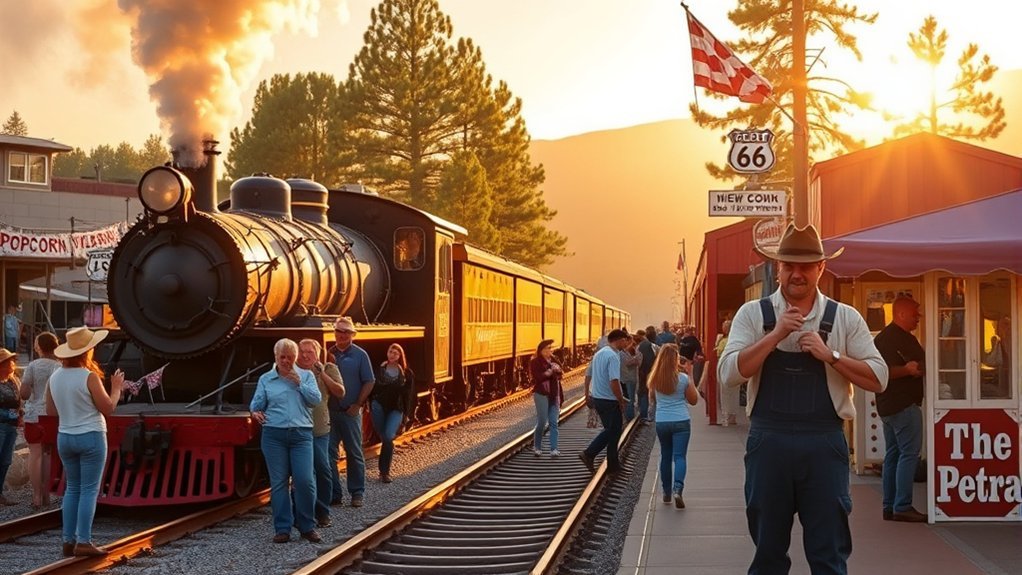
You’ll step into a lively celebration of rail history with historic train displays that put classic locomotives and vintage cars within arm’s reach. Local bands and headliners keep the downtown buzzing with a varied live music lineup throughout the weekend. With kid-friendly rides, hands-on exhibits, and food vendors, Railroad Days is easy to enjoy for the whole family.
Historic Train Displays
Step into a living slice of railroading history at Williams Annual Railroad Days, where vintage locomotives and restored cars line the tracks and steam whistles punctuate the mountain air. You’ll wander displays that showcase craftsmanship, engineering, and stories from the golden age of rail. Touch polished brass, study original gauges, and watch crews fire up engines while docents explain restoration techniques. Don’t miss photo ops against towering steam stacks or the chance to compare eras of passenger comfort.
- See century-old steam and diesel locomotives up close
- Explore restored cabooses and sleeper cars
- Learn about track technology and signaling evolution
- Talk with volunteers restoring rolling stock
These displays make history tangible and unforgettable.
Live Music Lineup
Often the air around the depot hums with live music, and at Railroad Days the lineup brings a lively mix of Americana, bluegrass, classic rock, and folk that keeps feet tapping between train displays. You’ll find a rotating schedule of local bands and regional acts on multiple stages, each set timed so you can catch favorites without missing demonstrations. Sound levels stay friendly, conversation-friendly during softer sets and electric when headliners arrive. Read the program ahead, mark start times, and arrive early for the best viewing spots. Vendors nearby serve refreshments while volunteers pass out schedules and performer bios. Whether you want toe-tapping rhythms or storytelling ballads, the curated lineup offers a genuine slice of Northern Arizona’s music scene.
Family-Friendly Activities
After you’ve enjoyed a set or two, wander over to the family-friendly heart of Railroad Days where hands-on fun and kid-focused programming keep everyone smiling. You’ll find activities that spark curiosity and let kids burn off energy while you relax. Hands-on exhibits teach about trains and local history, interactive crafts let little ones take home treasures, and short narrated trolley rides give a taste of vintage travel. Food vendors offer kid-approved snacks and shaded seating, so you can regroup between events. Plan around the parade and timed story sessions to catch highlights.
- Model train displays with moving layouts
- Craft booths and face painting
- Short narrated trolley rides
- Kid-friendly stage performances
Visit Pete’s Route 66 Gas Station Museum
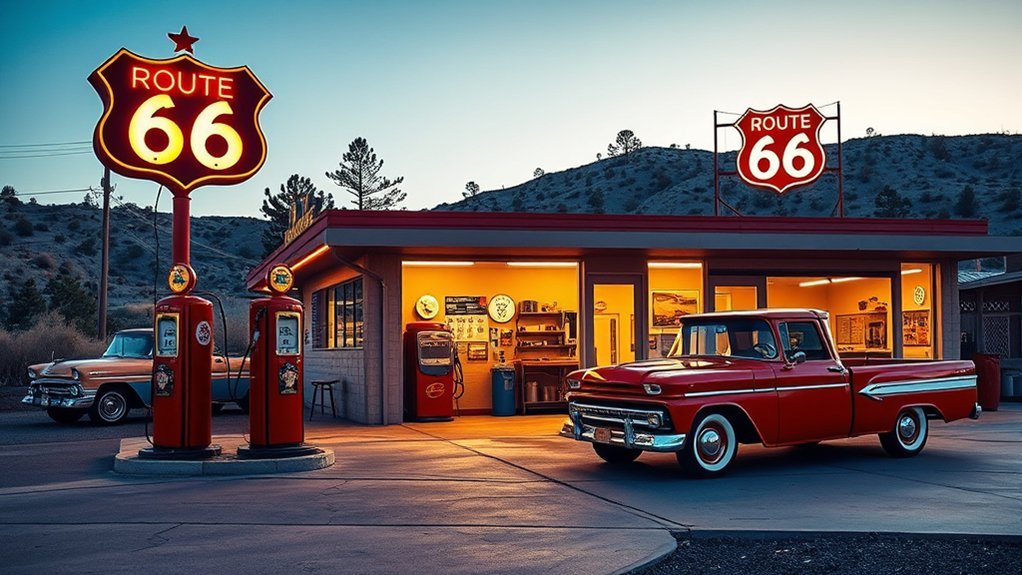
Drop into Pete’s Route 66 Gas Station Museum and you’ll be transported back to the heyday of roadside travel, where gleaming pumps, vintage signs, and a compact collection of automobilia tell the story of Route 66 through the eyes of a local collector. You’ll wander a small, lovingly curated space filled with restored gasoline pumps, enamel signs, license plates, and period advertising that feel authentic rather than staged. Pete’s personal anecdotes, often posted on placards, give context to each piece and connect you to Williams’ role on the Mother Road. Take your time to study the details—paint chips, logo evolution, and service-station tools—that reveal how motoring culture evolved. Photography’s allowed, so you can capture quirky artifacts and share them later. The museum is easy to fit into a half-hour stop between other downtown attractions, and the admission supports preservation. If you appreciate Americana or roadside history, this tucked-away gem is well worth a short detour.
Go Fishing at Kaibab Lake
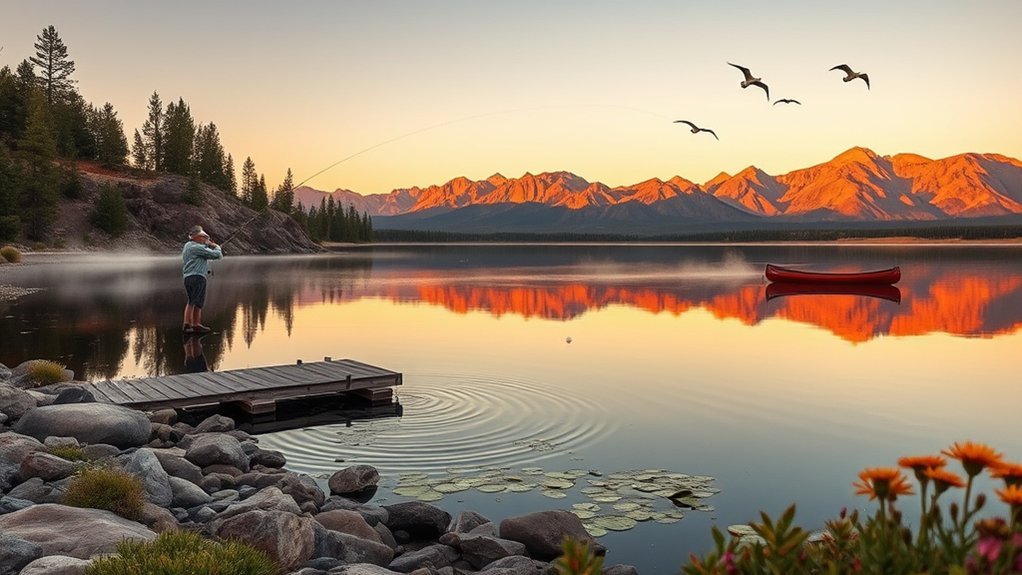
A short drive from downtown Williams brings you to Kaibab Lake, a peaceful spot where you can cast a line into cool, clear water surrounded by pine and aspen. You’ll find shorelines ideal for wading, a small boat ramp if you prefer to float, and calm afternoons filled with trout rising. Pack a light tackle box, a valid Arizona fishing license, and layers—the high-country breeze can shift quickly.
- Choose gear: light spinning rod, 4–8 lb line, small spinners or PowerBait.
- Best times: early morning or dusk for active trout.
- Access: paved parking, accessible paths, and a boat ramp for kayaks or small boats.
- Rules: check daily limits and seasonal closures, practice catch-and-release where posted.
You’ll enjoy quiet forest views, attentive birdlife, and the satisfying tug on your line—Kaibab Lake makes fishing simple, scenic, and rewarding.
Explore the Grand Canyon Deer Farm (Petting Zoo)
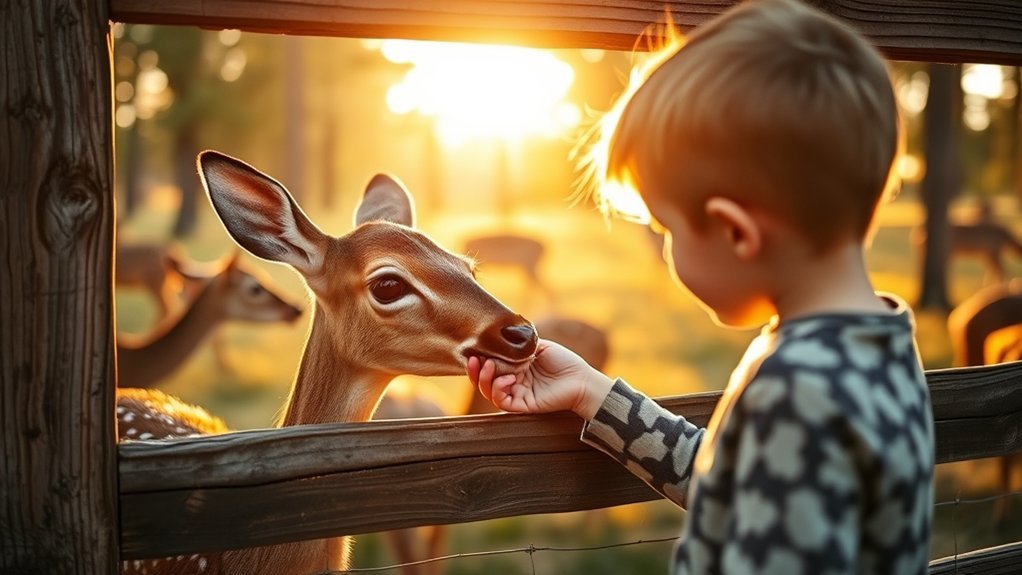
Often you’ll find the Grand Canyon Deer Farm delightfully hands-on, where you can stroll through shady enclosures, feed gentle deer and other friendly farm animals, and snap close-up photos without barriers. You’ll arrive to a relaxed, family-friendly vibe: gravel paths, wooden fences, and signs that explain each animal’s habits. Staff are approachable and will show you the proper way to hand-feed pellets and veggies so shy animals feel safe. Expect to meet miniature donkeys, goats, llamas, and several deer breeds, each with distinct coats and personalities. Educational displays describe local habitat and responsible interaction, making the visit both fun and informative for kids and adults. Bring a camera, wear comfortable shoes, and carry small change for feed vending machines. Visits are typically short — an hour or so — but you can linger on benches beneath pines. The Deer Farm offers an intimate, low-key animal encounter that’s perfect for animal lovers and anyone wanting an up-close, memorable experience near Williams.
Enjoy a Scenic Horseback Ride
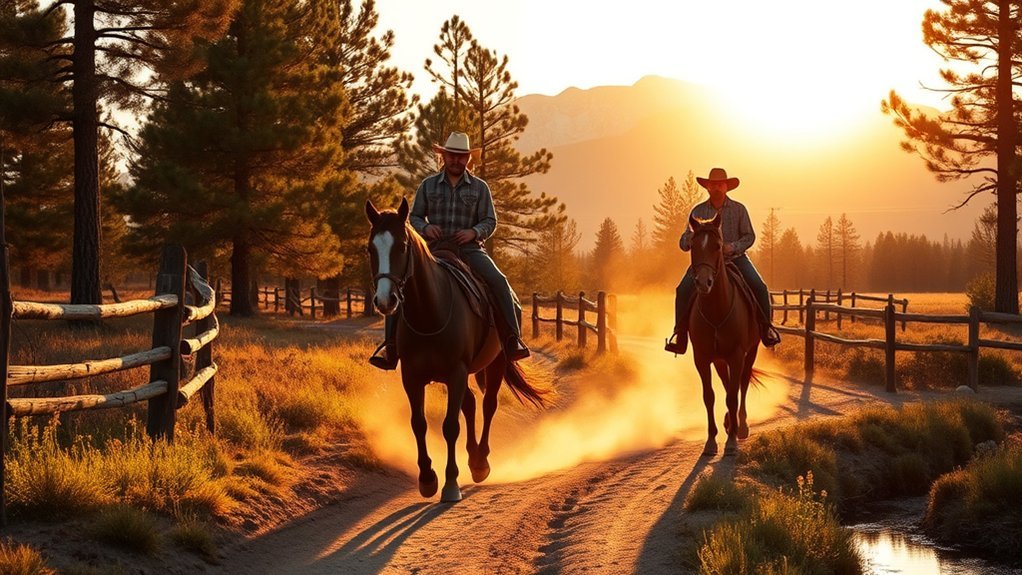
Beneath the high pines and wide Arizona sky, you’ll saddle up for a relaxed, scenic horseback ride that showcases Williams’ forests, meadows, and red-rock vistas without demanding prior experience. Guided rides wind along shaded trails, where the rhythm of hooves and the scent of ponderosa create a peaceful, attentive pace. You’ll learn basic cues, enjoy photo stops at overlooks, and feel grounded as the landscape unfolds.
Beneath high pines and wide Arizona sky, a relaxed horseback ride unveils forests, meadows, red‑rock vistas—peaceful, guided, and beginner-friendly
- Trail options: choose short beginner loops or longer ridge rides.
- Timing: morning coolness or golden-hour light for best views.
- What to bring: closed-toe shoes, layered clothes, water, camera.
- Safety: helmets available, guides match horses to riders.
The guides share local history and point out wildlife, making the outing both scenic and informative. Rides suit families and solo travelers, and they offer a tactile, quieter way to connect with northern Arizona’s varied terrain without strenuous effort.
Visit Kaibab National Forest Visitor Center
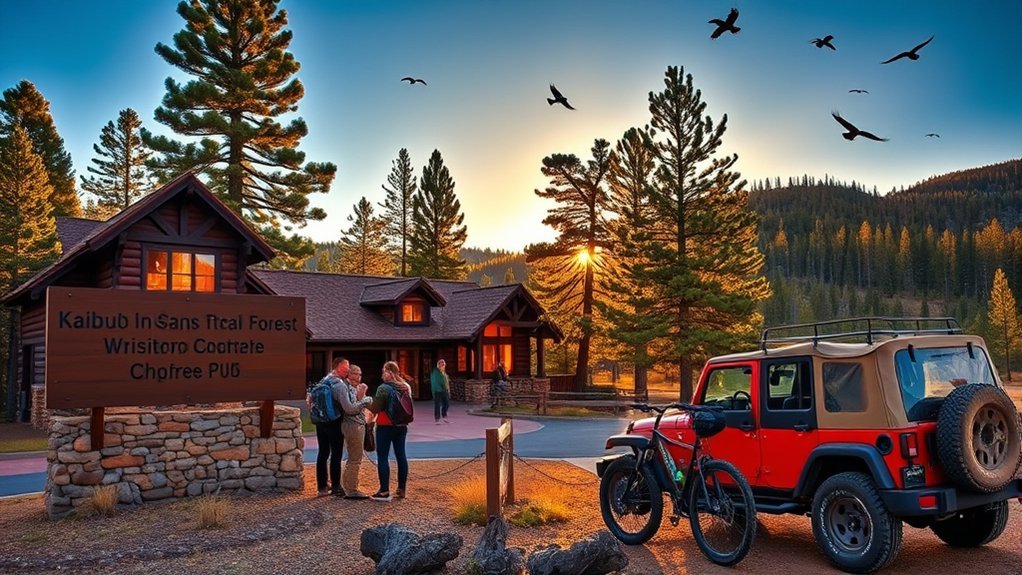
After your horseback ride, head to the Kaibab National Forest Visitor Center to extend your outdoor experience with maps, trail advice, and exhibits on local ecology and history. You’ll find friendly staff who’ll point out seasonal highlights, explain elevation changes, and suggest short walks that reveal ponderosa pines, aspen groves, and birdlife. Interactive displays show how fire, water, and people shaped this landscape, and a small shop stocks topo maps and field guides if you want to explore independently.
| Feature | What You’ll See | Why It Matters |
|---|---|---|
| Maps | Detailed trails, contour lines | Plan safe routes |
| Exhibits | Wildlife skins, photos | Learn local species |
| Staff Tips | Route times, hazards | Save time and trouble |
| Displays | Fire ecology, geology | Understand the forest |
| Shop | Maps, guides, snacks | Quick supplies before hikes |
Before you go, ask about seasonal road conditions and ranger programs — they’ll make your visit richer and safer.
Hike Bill Williams Mountain Trail
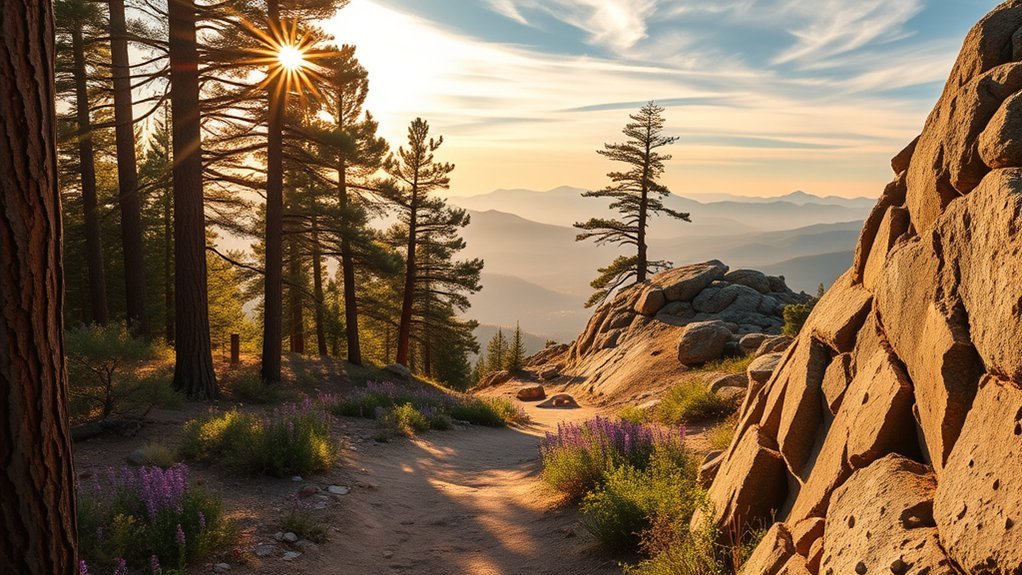
You’ll find the Bill Williams Mountain Trail offers a clear route of about 3–5 miles round trip depending on which connector you choose, so plan for the distance that fits your pace. The climb gains several hundred feet and can feel strenuous in places, especially at higher elevation where thinner air makes it tougher; bring layers and sturdy footwear. Keep an eye out for elk, deer, and native birds, and check seasonal conditions—snow can linger into spring and summer thunderstorms can roll in fast.
Trail Overview and Distance
While the Bill Williams Mountain Trail climbs through mixed pine and aspen forest, it gives you a clear sense of elevation and variety: the trail stretches roughly 3.5 miles one way to the summit area, gaining about 1,400 feet, and follows well-marked switchbacks and occasional rock steps that keep the grade manageable. You’ll find clear signage at the trailhead and junctions, with a packed dirt path that’s easy to follow even when leaf litter covers short sections. The route reveals changing vistas as you ascend, opening to distant ridgelines and meadow pockets. Key practical details to note:
- Trail length: ~3.5 miles one way.
- Round-trip distance: ~7 miles.
- Surface: packed dirt, occasional rocks.
- Trail markers: frequent and visible.
Elevation and Difficulty
Because the trail climbs about 1,400 feet over roughly 3.5 miles, expect a steady, moderate ascent that will test your legs without being overly technical. The grade stays consistent, with some rocky steps and short steeper pitches; you’ll use steady pacing and short breaks to keep energy up. Trail surface varies from packed dirt to loose gravel, so sturdy shoes help. Navigation is straightforward—follow cairns and occasional posts—but pay attention where switchbacks tighten. Altitude can make breathing feel slightly harder near the summit, so move deliberately. Below is a quick reference to set expectations and plan your effort.
| Feature | What to Expect | Tip |
|---|---|---|
| Elevation Gain | ~1,400 ft | Pace evenly |
| Distance | 3.5 miles one-way | Bring water |
| Terrain | Dirt, gravel, rock | Wear good shoes |
| Difficulty | Moderate | Rest on switchbacks |
Wildlife and Seasonal Tips
If you visit Bill Williams Mountain at different times of year, you’ll notice the wildlife and plant life shift dramatically—spring brings wildflowers and active songbirds, summer heats up with more reptile sightings, and cooler months favor elk and mule deer moving to lower elevations. You’ll want to plan timing, gear, and pace to match seasonal behavior. Watch quietly at dawn for songbirds and jays; scan ridgelines at dusk for silhouettes of elk. Stay on trail to protect fragile flora and avoid startling animals. Carry water, sun protection, and a light jacket—temperatures change fast. Consider a small binocular and field guide to identify species. Keep dogs leashed and pack out waste to preserve habitat.
- Check seasonal trail conditions
- Dawn/dusk wildlife windows
- Bring binoculars and guide
- Respect wildlife space
Join a Stargazing or Night-Sky Program
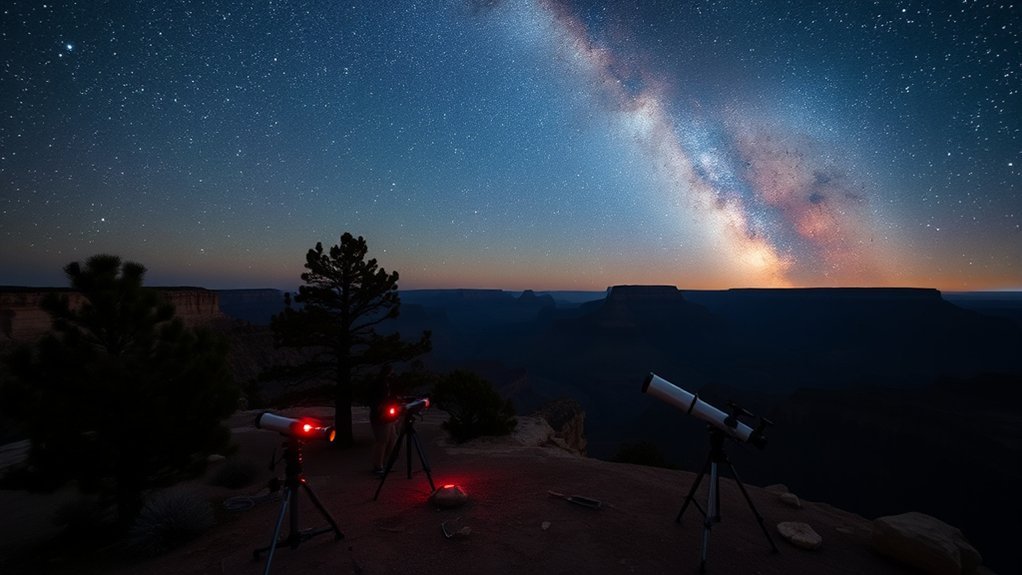
Under the clear, high-desert skies around Williams you can join guided stargazing programs that bring constellations, planets and the Milky Way into sharp, surprising focus. You’ll gather at dark-sky sites or small observatories where knowledgeable guides point out seasonal constellations, explain celestial mechanics, and show you deep-sky objects through quality telescopes. Expect crisp air, quiet horizons and amplified views of Jupiter’s cloud bands, Saturn’s rings or faint nebulae that don’t register from city streets.
Programs often include hands-on telescope use, star charts, and apps to help you continue learning after the session. Some evenings pair astronomy with stories about native sky lore or science talks suited to families and curious adults. Bring layered clothing, a red-light flashlight, and binoculars if you have them. Check schedules for moon phases and weather—darker nights yield the best Milky Way panoramas. Whether you’re a novice or hobbyist, a guided night-sky program turns Williams’ impressive celestial canvas into a memorable, educational experience.
Take a Day Trip to the South Rim of the Grand Canyon
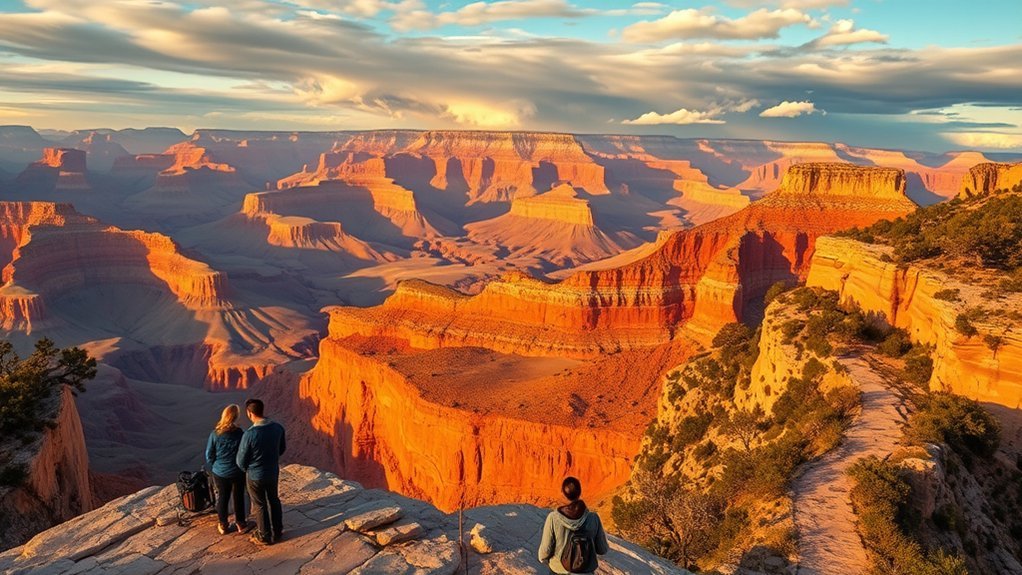
Want to see one of the planet’s most awe-inspiring vistas by lunchtime? Drive or take the Grand Canyon Railway from Williams and you’ll arrive at the South Rim with time to spare. You’ll stand at rim viewpoints where layered reds and shadowed canyons stretch to the horizon, the Colorado River visible far below. Plan for comfortable walking shoes, sunscreen, and a camera — weather changes fast.
- Ride the historic Grand Canyon Railway for a scenic, relaxing trip.
- Stop at Mather Point, Yavapai Observation Station, and Bright Angel Trail overlooks.
- Join a ranger program or grab a park shuttle to maximize viewpoints.
- Pack snacks, water, and a light jacket for variable temperatures.
You can tailor the day to a brisk panorama tour or a more measured exploration with short hikes and interpretive stops. Return to Williams by evening, carrying one of the Southwest’s most unforgettable panoramas in your memory.
Play at Williams Rodeo Grounds or Catch a Rodeo
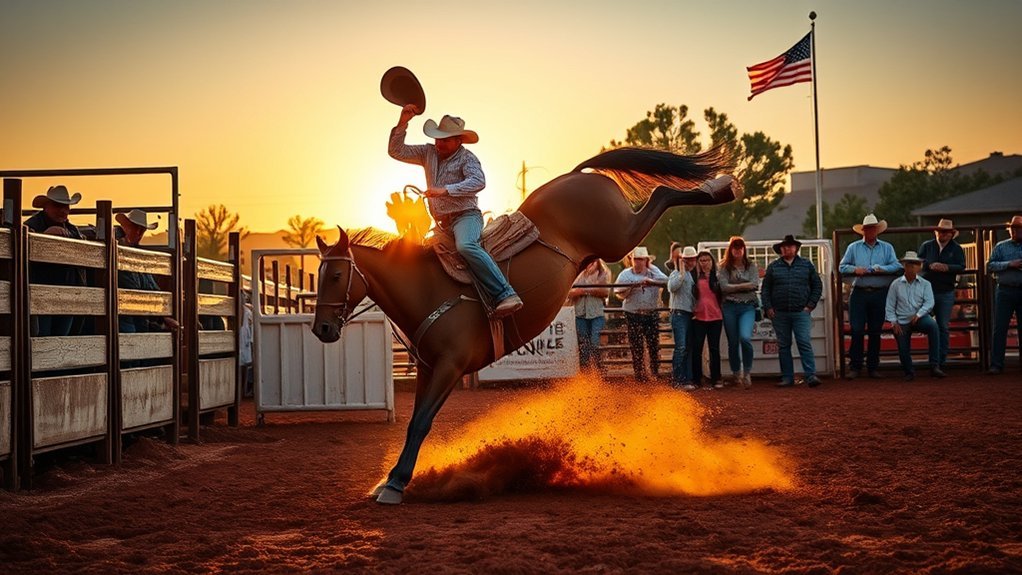
Check the rodeo schedule before you go so you can catch special events like barrel racing, bull riding, or theme nights. Buy tickets in advance when possible and arrive early for the best seating and easy parking. Bring sunscreen and a hat—evening shows cool off, but daytime stands are exposed.
Rodeo Schedule & Events
If you’re looking for high-energy local entertainment, the Williams Rodeo Grounds host regular rodeos, special events, and family-friendly activities throughout the season. You’ll find evenings of bull riding, barrel racing, and steer wrestling that showcase local talent and visiting competitors. The schedule changes by month, so plan around peak summer weekends and holiday-themed shows. Expect a lively atmosphere with concessions, live announcers, and community booths.
- Weekly summer rodeos — fast-paced nightly performances.
- Championship weekends — higher stakes, pro-level riders.
- Family days — kids’ events, pony rides, and demonstrations.
- Special events — parades, rodeo queen contests, and benefits.
Check the rodeo’s calendar online or call the grounds for up-to-date dates and special announcements.
Ticketing & Seating Tips
Because rodeo nights fill up fast during peak season, plan your tickets and seats in advance so you’re not stuck on bleachers or missing favorite events. Check the Williams Rodeo Grounds website or call the box office for ticket release dates and seating maps; popular nights and special events sell out early. Choose lower-rail seats for close-up action or shaded sections if heat’s a concern—bring a cushion for wooden benches. If general admission’s your choice, arrive early to claim a good spot and scout restroom and concession access. Look for family or group discounts, military pricing, and advance-purchase online deals. Keep electronic tickets handy, but print a backup. With a little prep you’ll enjoy every rider, chute and high-flying moment.
Sample Local Brews at a Williams Brewery or Taproom
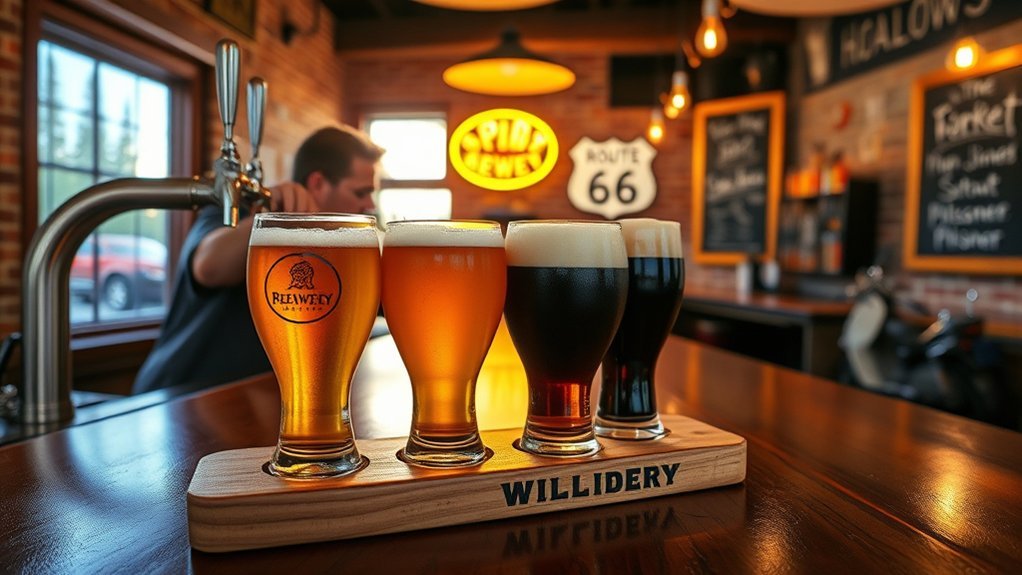
Often you’ll find the lively hum of conversation and the smell of fresh hops in a Williams taproom, where local breweries pour creative ales and small-batch lagers you won’t taste anywhere else. You can order a flight to sample several styles—hoppy IPAs, roasty porters, crisp pilsners, and seasonal sours—while bartenders explain tasting notes and brewing methods. Sit at reclaimed-wood tables, chat with brewers, and learn what makes their water, malt, and yeast unique to northern Arizona. Pair a sampler with house snacks or food-truck fare for a fuller experience.
- Try a flight to compare five small-batch pours side-by-side.
- Ask for brewer recommendations based on flavor preferences.
- Attend a taproom release to taste limited-edition batches.
- Pick up a growler or cans to enjoy later.
You’ll leave with favorite labels to seek out and a better appreciation for Williams’ growing craft-beer scene.
Photograph Historic Motels and Vintage Signage
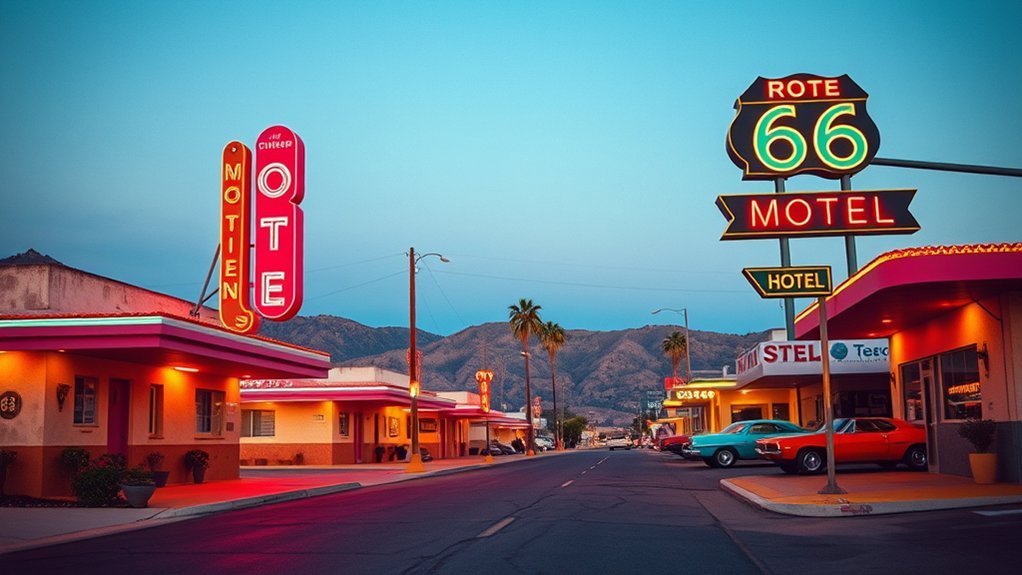
Looking for picture-perfect slices of Americana? Head down Route 66 through Williams and let your camera hunt for neon, chipped paint, and quirky architecture. You’ll find motels with retro façades, classic neon signs humming at dusk, and roadside billboards that tell stories of mid-century travel. Look for bold typography, chrome trim, and hand-painted murals—those details make striking close-ups and wide-angle compositions.
Shoot during golden hour to capture warm tones and long shadows, and use a polarizer to deepen skies and tame reflections on glass. Frame signs against textured brick or the pine-studded horizon to give images context. Respect private property: stay on public sidewalks and ask permission if you need closer access. Keep an eye out for subtle contrasts—faded pastels beside bright neon—or include a passing car for motion and era contrast. You’ll leave with a visual scrapbook of Williams’ roadside heritage and plenty of shareable shots.
Relax at a Cozy Bed-And-Breakfast or Historic Inn
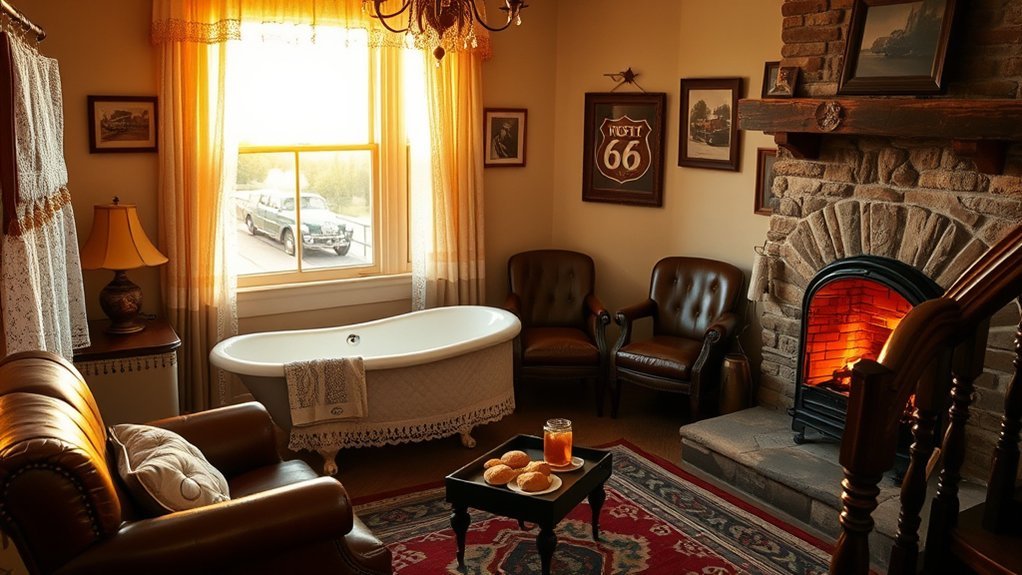
Unwind in a cozy bed-and-breakfast or historic inn where antique furnishings, homemade breakfasts, and quietly creaking floorboards feel like a warm welcome home. You’ll step into rooms that echo Williams’ past—lace curtains, wood-stove warmth, and framed Route 66 photos—while hosts hand you a steaming cup of coffee and local tips. Mornings bring skillet breakfasts, seasonal jams, and a slow start before you head out to explore. Evenings are for porch rockers, stargazing, and swapping stories with other travelers.
- Choose a room with period decor for charm and quiet.
- Ask hosts about private guided hikes, dinner spots, and train schedules.
- Sample the breakfast specialties—think skillet potatoes, fresh fruit, and house preserves.
- Book a suite with a balcony or fireplace for a romantic or restorative stay.
You’ll leave refreshed, knowing you experienced Williams’ hospitality in a setting that’s intimate, historic, and distinctly local.
Frequently Asked Questions
Are There Medical Facilities or Urgent Care in Williams?
Yes — you’ll find a small medical clinic and an urgent care in Williams for basic needs; for ER services and specialists, you’ll drive about 30–60 minutes to Flagstaff or surrounding towns depending on the situation.
Is Williams Pet-Friendly Beyond Bearizona and the Deer Farm?
Yes — you’ll find plenty of paw-approved spots. Many downtown shops, patios, trails and some lodgings welcome pets, though policies vary; call ahead, pack supplies, and enjoy leash-friendly parks and pet-friendly eateries around town.
What Are the Cell Phone and Internet Coverage Areas?
Cell and internet coverage is spotty in and around Williams: town center and main highways have decent LTE from major carriers, but you’ll encounter weak or no signal in forested, rural, and canyon areas—plan offline maps and backups.
Where Can I Charge an Electric Vehicle in Town?
You can charge your EV at public stations by the Williams Visitor Center, several hotels (including Grand Canyon Railway Hotel), and the Safeway/ACE Hardware area; destination chargers are scattered downtown, and some restaurants offer level 2 chargers.
Are There Accessible Routes and Services for Visitors With Mobility Impairments?
Absolutely — you’ll find accessible routes and services throughout town, including curb cuts, ramps, ADA parking, wheelchair-friendly sidewalks, and many businesses with accessible entrances; staff are helpful, and adaptations make exploring easier than you’d ever imagine.
Conclusion
You’ll leave Williams with a pocket full of neon memories and a heart tuned to the click-clack of the Grand Canyon Railway — I once watched an elderly couple dance by the depot, their laughter sparking like Route 66 bulbs — proof this town’s charm is a living postcard. With 150 miles of Kaibab trails and cozy inns lining Railroad Avenue, you’ll keep coming back for the scenery, the stories, and that timeless small-town magic.

